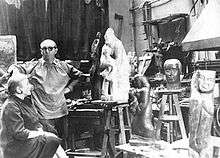Marek Szwarc
| Marek Szwarc | |
|---|---|
 Marek Szwarc in his Cité fleurie studio in Paris. | |
| Born |
May 9, 1892 Zgierz, near Lodz, Poland |
| Died |
December 28, 1958 (aged 66) Paris |
| Nationality | Polish, later French |
| Movement | School of Paris, Yung-yidish |
| Website | http://marekszwarc.com/ |
Marek Szwarc was a painter and sculptor associated with the School of Paris (Ecole de Paris),[1] as well as with the Yiddish cultural avant-garde movements in Poland Khalyastre, and Yung-yidish[2]. He was born in Zgierz, Poland on May 9, 1892 and died in Paris, France on December 28, 1958.
Early years
From 1910 to 1914, Szwarc lived and studied art at the Ecole des Beaux Arts in Paris. He boarded at la Ruche together with Soutine, Marc Chagall, Modigliani and Kremegne, and together with Tchaikov and Lichtenstein inaugurated the first Jewish art journal Makhmadim (Precious Ones). In 1913 he exhibited his first sculpture, Eve, in the Salon d'Automne.
Between 1914 and 1917, Szwarc traveled through the Russian Empire, spending time in Odessa and Kiev, and working in the Jewish literary circle of Mendele Moykher-Sforim, Ahad Ha-Am, and Ḥayim Naḥman Bialik. In 1918 he founded – together with Moyshe Broderzon and a group of visual artists centered around Yitskhok Broyner and Yankl Adler – the Yung-yidish, the first Yiddish artistic avant-garde group in Poland.[3]
During the First World War Szwarc returned to Poland. In 1919 he met and married his wife, Guina, a writer, and together they returned to Paris after the war. Until the Second World War, Szwarc lived in Paris and his paintings and sculptures were bought by collectors in Germany, Poland, the United States, and by several museums. It was during this period between the wars that he produced some of his most outstanding and original work in hammered copper, exhibited in the Salon des Tuileries and the subject of a monograph by the celebrated art critic Louis Vauxcelles. Vauxcelles writes of Szwarc:
%2C_Warsaw._Illustration_by_Marek_Szwarc.png)
"By virtue of its poetic concepts, by its firm and generous execution, by the sense of its cadenced dispositions, by the sharp graphics written in view of the material and which commands this very material, it is apparent that Marek Szwarc is in harmony with the most audacious innovators of our times, who seek him out and see him as a maître".[4]
In 1922 to 1923 Szwarc contributed to the Berlin and Warsaw based avant-garde Yiddish Journal Albatros (אלבאַטראָס), edited by poet and publicist Uri Zvi Greenberg.[5]
Later years
When Poland fell in 1939, Szwarc volunteered for the Polish army in exile and after the occupation of France he escaped with the Polish army to Scotland, while his family fled via Lisbon to England. It was during this period (1940–1943) that he drew a series of pen and ink drawings depicting the daily life of his fellow soldiers.
After the war he returned to Paris with his wife and daughter, Tereska Torres who had served in the Free French Forces of General Charles de Gaulle in London. She published two books dealing in large part with the life of her father. After the war Marek Szwarc devoted most of his time to sculpting in stone and wood and casting in bronze. Some of these works have been donated to the Musee d'art et d'Histoire du Judaisme in Paris.[6]
Death
Marek Szwarc died suddenly at the age of 66. His wife, Guina died in Paris in 1973. Today he is survived by his grandchildren. In 2010 the French publishing house ressouvenances.fr brought out an edition of Szwarc's memoirs, which he dictated to his wife Eugenia (Guina) Markowa in 1954 titled Marek Szwarc: Memoires entre deux mondes.
Works and exhibitions

Szwarc's work, broadly identified in style with the Ecole de Paris, was frequently but not exclusively concerned with biblical themes from the Old and New Testament. The latter motifs coming into play after his conversion to Catholicism in 1919. His identity as a Jew, however, never wavered, as is evidenced in his article, The National Element in Jewish Art, published in a Yiddish literary journal in Warsaw in 1925.
He exhibited in Sweden, Austria, France, Canada, Belgium, Poland, and several sculptures were bought by the French government.
The artist's works are on display in museums, public halls, places of worship, and private collections in Poland, Israel, Montreal, Caracas, the United States, and England.
References
- ↑ Nieszawer, Nadine. "Nieszawer & Princ Bureau d'expertise -". www.ecoledeparis.org. Retrieved 2016-08-01.
- ↑ "YIVO | Khalyastre". www.yivoencyclopedia.org. Retrieved 2016-08-10.
- ↑ "YIVO | Yung-yidish". www.yivoencyclopedia.org. Retrieved 2016-08-06.
- ↑ "Marek Szwarc". www.marekszwarc.com. Retrieved 2016-08-01.
- ↑ LIPSKER, AVIDOV; BAR-ILAN, RUTH (1995-01-01). "The Albatrosses of Young Yiddish Poetry: An Idea and Its Visual Realization in Uri Zvi Greenberg's Albatros". Prooftexts. 15 (1): 89–108. JSTOR 20689408.
- ↑ "Fonds d'atelier de Marek Szwarc Nouvelles acquisitions dans les collections du Mahj". www.mahj.org. Retrieved 2016-07-17.
External links
- Official website
- Nadine Nieszawer, Ecole de Paris
- Otto Schneid papers, correspondence with Marek Szwarc and essays by Schneid and Ludwig Lewisohn.
- Works by Marek Szwarc in the collection of the Musee d'art et d'Histoire du Judaisme in Paris.